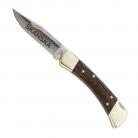 Buck Folding Hunter Lockback Knife 110
Buck Folding Hunter Lockback Knife 110
Funny you should ask. How can you predict the future of anything? Here are some basic techniques that knife predictors might use:
- To see what a knife will look like in 100 years from now, lets see what it looked like 100 years AGO.
- Then look at the changes that were made, and when they were made. Did most of the changes occur in the last 10 years? If so, then you could expect more changes to come at a faster rate. If changes occurred every 10 years for the last 100 years, then you could expect the same steady rate of change in the next 100 trips around the sun.
- See the health of the knife company, and how well they respond to the needs of its customers.
What will Buck Knives be like in 2116? To try and answer that, let’s follow the 3 steps shown above…
- I can’t find a picture of the original Buck knife, made in 1902 by Hoyt Buck, the founder. If you can, please post it here.
- Buck Knives have changed gradually over the last 100 years. At the halfway mark, the son of Hoyt, Al Buck, incorporated “Buck Knives“. In 1963-1964, Al designed and started to manufacture the famous 110 Buck Folding Hunter knife. At 4 7/8” closed, this knife has been the flagship of all pocket knives. It made the name “buck knife” a household name. When someone would say that name, they would mean a good pocket knife. Al’s son Chuck and his wife, Lori worked at the plant, too, since 1978. Then in 1999 CJ took over the company. His father, Chuck died in 2015. So CJ is the great grandson of the originator, Hoyt Buck.
 Buck USA Stockman Knife 301
Buck USA Stockman Knife 301You can say that the next hundred years may continue to show a steady development of methods, design, and products to keep Buck knives the major US pocket knife company.
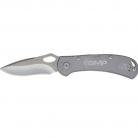 Buck® Spitfire 722
Buck® Spitfire 722 - How does this knife company respond to the needs of its customers? Starting with the founder, Hoyt Buck, he was looking for a way to temper steel. A better steel would be able to receive and hold a sharper edge. He had the American people in mind. Chuck responded to the customers in 1963 when they wanted a hunting knife that would fold. Not only fold, but lock in the open position, so you wouldn’t hurt yourself. This 110 Buck Folding Hunter knife was the best thing since sliced bread. So point 3 gets a passing grade for Buck. Most Buck knives are USA made.
 Buck Nobleman Linerlock Knife 327
Buck Nobleman Linerlock Knife 327 But in response to the economic cries of its customers, Buck does import some fine pocket knives. Camo (camouflage) has become very popular, so Buck responded with a few camo handles and even orange camo handles. Tactical knives are now taking center stage in the pocket knife collectors. Buck has designed some great example of that.
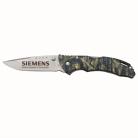 Buck® Nano Bantam Camo 284cmo
Buck® Nano Bantam Camo 284cmo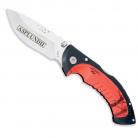 Buck® Folding Orange Camo Omni Hunter 395CM9
Buck® Folding Orange Camo Omni Hunter 395CM9
What Will Buck Knives Be Like in 100 Years? My best guess would be more of the tactical style, and survival style of knives. However, for those who reminisce, Buck will always produce the 110 Buck Folding Hunter knife that has survived over 50 years. It is the flagship of all pocket knives.
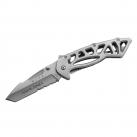 Buck® Silver “Bones” Pocket Knife 870-S
Buck® Silver “Bones” Pocket Knife 870-S
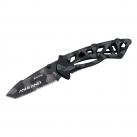 Buck® “Bones” – Tiger Stripe 870-TS
Buck® “Bones” – Tiger Stripe 870-TS

